人教版高中英语必修2第4单元教案
- 格式:doc
- 大小:328.50 KB
- 文档页数:9

Period Three Discovering Useful Structures—Past participles(1) as the attribute and the object complement感知以下句子,完成方框下的小题1.Most people just use the shortened name:“the United Kingdom” or “the UK”.2.They use the same flag,known as the Union Jack,as well as share the same currencyand military defence.3.They had castles built all around England,and made changes to the legal system. 4.The peaceful landscape of the “Emerald Isle” and its many green counties is atrue feast for the eyes,with its rolling green hills dotted with sheep and cattle. 5.Judy and I had our car parked in an underground car park near Trafalgar Square,where we could get our car battery charged.6.When we finally reached the service desk to ask for audio guides,we heard it announced that there were no audio guides left.1.句1和2中加黑词汇在句中作定语。
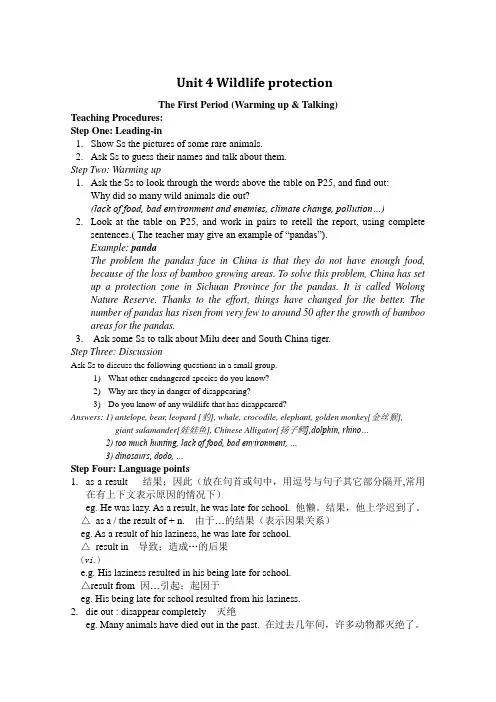
Unit 4 Wildlife protectionThe First Period (Warming up & Talking)Teaching Procedures:Step One: Leading-in1.Show Ss the pictures of some rare animals.2.Ask Ss to guess their names and talk about them.Step Two: Warming up1.Ask the Ss to look through the words above the table on P25, and find out:Why did so many wild animals die out?(lack of food, bad environment and enemies, climate change, pollution…)2.Look at the table on P25, and work in pairs to retell the report, using completesentences.( The teac her may give an example of “pandas”).Example: pandaThe problem the pandas face in China is that they do not have enough food, because of the loss of bamboo growing areas. To solve this problem, China has set up a protection zone in Sichuan Province for the pandas. It is called Wolong Nature Reserve. Thanks to the effort, things have changed for the better. The number of pandas has risen from very few to around 50 after the growth of bamboo areas for the pandas.3. Ask some Ss to talk about Milu deer and South China tiger.Step Three: DiscussionAsk Ss to discuss the following questions in a small group.1)What other endangered species do you know?2)Why are they in danger of disappearing?3)Do you know of any wildlife that has disappeared?Answers: 1) antelope, bear, leopard [豹], whale, crocodile, elephant, golden monkey[金丝猴], giant salamander[娃娃鱼], Chinese Alligator[扬子鳄],dolphin, rhino…2) too much hunting, lack of food, bad environment, …3) dinosaurs, dodo, …Step Four: Language points1.as a result 结果;因此(放在句首或句中,用逗号与句子其它部分隔开,常用在有上下文表示原因的情况下)eg. He was lazy. As a result, he was late for school. 他懒。
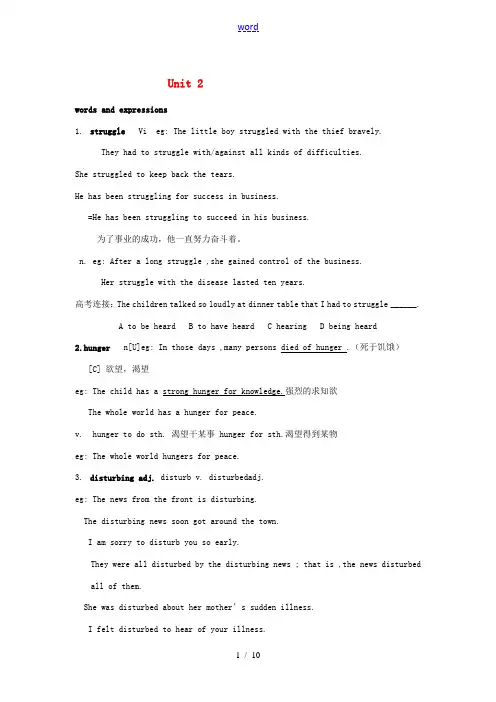
Unit 2words and expressions1.struggle Vi eg: The little boy struggled with the thief bravely.They had to struggle with/against all kinds of difficulties.She struggled to keep back the tears.He has been struggling for success in business.=He has been struggling to succeed in his business.为了事业的成功,他一直努力奋斗着。
n. eg: After a long struggle ,she gained control of the business.Her struggle with the disease lasted ten years.高考连接:The children talked so loudly at dinner table that I had to struggle ______.A to be heardB to have heardC hearingD being heard2.hunger n[U]eg: In those days ,many persons died of hunger .(死于饥饿)[C] 欲望,渴望eg: The child has a strong hunger for knowledge.强烈的求知欲The whole world has a hunger for peace.v. hunger to do sth. 渴望干某事 hunger for sth.渴望得到某物eg: The whole world hungers for peace.3.disturbing adj. disturb v. disturbedadj.eg: The news from the front is disturbing.The disturbing news soon got around the town.I am sorry to disturb you so early.They were all disturbed by the disturbing news ; that is ,the news disturbed all of them.S he was disturbed about her mother’s sudden illness.I felt disturbed to hear of your illness.4.expand eg:The eagle expanded his wings.He is thinking of expanding his business.Metals expand when they are heated .Our foreign trade has expanded greatly in recent years.In ten years ,the city’s population expanded by 10%.搭配expand …. in/into…..把….扩展. expand on/upon 详细阐明Eg: He expanded his short story into a novel.I don’t understand your reasoning. Can you expand on it?5.thanks to eg; Thanks to your timely help, I managed to finish the work on time.It was thanks to his advice that I succeeded.表示“原因”的介词短语还有:due to(一般不放于句首) ; as a result of ,because of ;owing to ; on account of; in that(引导原因状语从句)eg:The accident was due to his careless driving .Owing to your timely help, we finished the work ahead of time.As a result of the bad weather ,the football match was put off.His request is unreasonable in that he knows we can't afford it.We delayed our departure on account of the bad weather.6.rid……of eg:You should rid yourself of the bad habit.We try to rid the house of mice.拓展get/be rid of 摆脱;除掉eg:I can’t get rid of this headache.She was glad to be rid of him.:warn sb. of sth.; inform sb. of sth. ; cure sb. of sth. ; rob sb.of sth.;7.be satisfied with eg:I was satisfied/pleased/content with the result.be satisfied to do 对做某事感到满意eg: He was satisfied to win the race.拓展: Some people are hard to satisfy.(vt)There was a satisfied look on his face.(adj)The answer was quite satisfying /satisfactory to him.(adj.)To our satisfaction, he accepted our invitation.(n.)8 .would rather eg: I would rather play football this afternoon, if you don’t mind.I’d rather not let him know the truth.Would you rather stay here or go home?I would rather stay at home than go out. =I would stay at home rather than go out.would rather 后跟从句时,表示主语宁愿让某人做某事,从句用虚拟语气即用一般过去时表示与现在或将来事实相反;用过去完成时表示与过去事实相反。
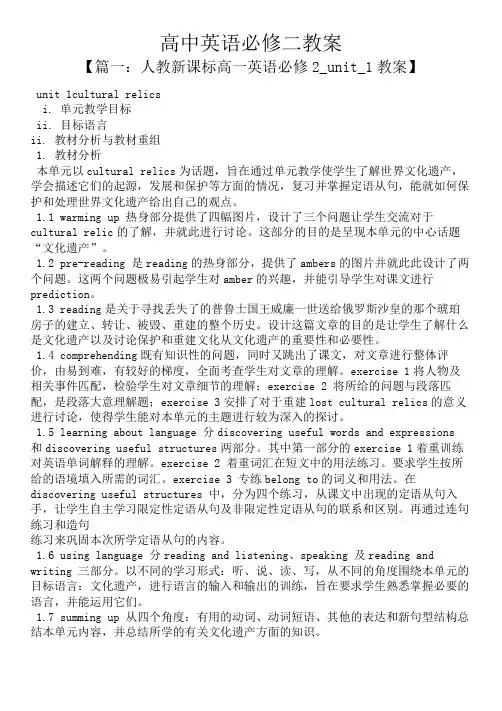
高中英语必修二教案【篇一:人教新课标高一英语必修2_unit_1教案】unit 1cultural relicsi. 单元教学目标ii. 目标语言ii. 教材分析与教材重组1. 教材分析本单元以cultural relics为话题,旨在通过单元教学使学生了解世界文化遗产,学会描述它们的起源,发展和保护等方面的情况,复习并掌握定语从句,能就如何保护和处理世界文化遗产给出自己的观点。
1.1 warming up 热身部分提供了四幅图片,设计了三个问题让学生交流对于cultural relic的了解,并就此进行讨论。
这部分的目的是呈现本单元的中心话题“文化遗产”。
1.2 pre-reading 是reading的热身部分,提供了ambers的图片并就此此设计了两个问题。
这两个问题极易引起学生对amber的兴趣,并能引导学生对课文进行prediction。
1.3 reading是关于寻找丢失了的普鲁士国王威廉一世送给俄罗斯沙皇的那个琥珀房子的建立、转让、被毁、重建的整个历史。
设计这篇文章的目的是让学生了解什么是文化遗产以及讨论保护和重建文化从文化遗产的重要性和必要性。
1.4 comprehending既有知识性的问题,同时又跳出了课文,对文章进行整体评价,由易到难,有较好的梯度,全面考查学生对文章的理解。
exercise 1将人物及相关事件匹配,检验学生对文章细节的理解;exercise 2 将所给的问题与段落匹配,是段落大意理解题;exercise 3安排了对于重建lost cultural relics的意义进行讨论,使得学生能对本单元的主题进行较为深入的探讨。
1.5 learning about language 分discovering useful words and expressions 和discovering useful structures两部分。
其中第一部分的exercise 1着重训练对英语单词解释的理解。
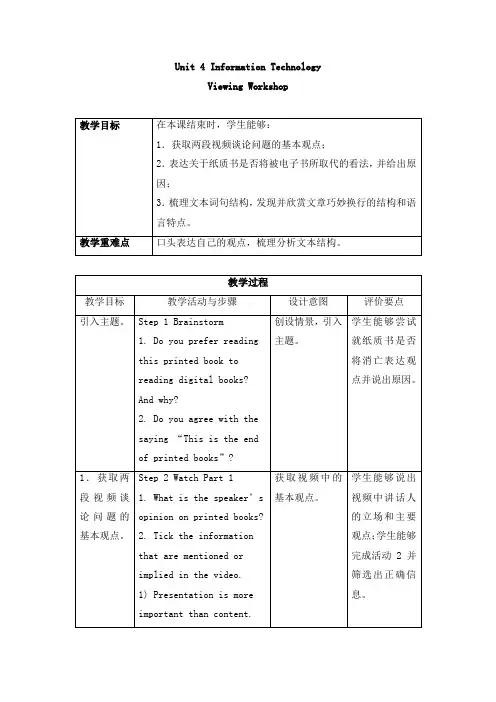
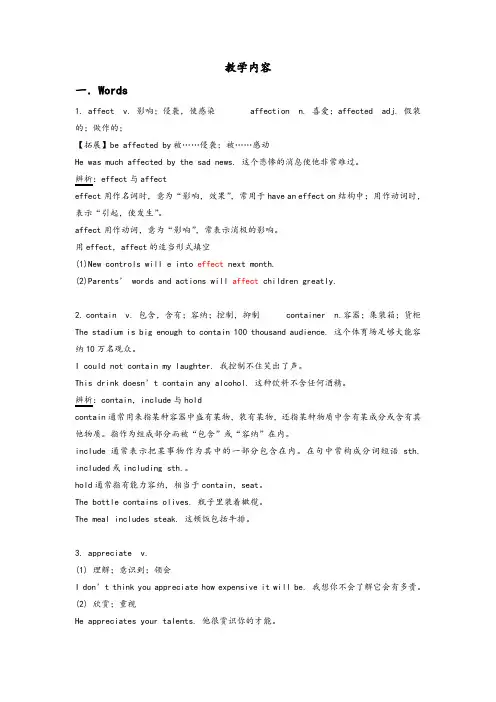
教学内容一.Words1. affect v. 影响;侵袭,使感染 affection n. 喜爱;affected adj. 假装的;做作的;【拓展】be affected by被……侵袭;被……感动He was much affected by the sad news. 这个悲惨的消息使他非常难过。
辨析:effect与affecteffect用作名词时,意为“影响,效果”,常用于have an effect on结构中;用作动词时,表示“引起,使发生”。
affect用作动词,意为“影响”,常表示消极的影响。
用effect,affect的适当形式填空(1)New controls will e into effect next month.(2)Parents’ words and actions will affect children greatly.2. contain v. 包含,含有;容纳;控制,抑制 container n.容器;集装箱;货柜The stadium is big enough to contain 100 thousand audience. 这个体育场足够大能容纳10万名观众。
I could not contain my laughter. 我控制不住笑出了声。
This drink doesn’t contain any alcohol. 这种饮料不含任何酒精。
辨析:contain,include与holdcontain通常用来指某种容器中盛有某物,装有某物,还指某种物质中含有某成分或含有其他物质。
指作为组成部分而被“包含”或“容纳”在内。
include通常表示把某事物作为其中的一部分包含在内。
在句中常构成分词短语sth. included或including sth.。
hold通常指有能力容纳,相当于contain,seat。
The bottle contains olives. 瓶子里装着橄榄。
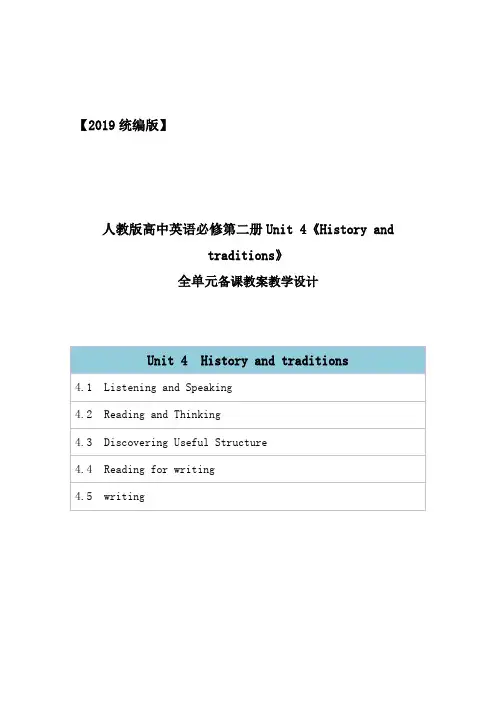
【2019统编版】人教版高中英语必修第二册Unit 4《History andtraditions》全单元备课教案教学设计Unit 4 HISTORY AND TRADITIONSListening and Speaking【教学目标】1. 掌握本课的重要词汇与句式;2. 引导学生通过课内听力训练,提高听力技巧,锻炼听力水平。
【教学重难点】1. 本课时的重要词汇与句式;2. 引导学生通过课内听力训练,提高听力技巧,锻炼听力水平。
【教学过程】Step 1 Lead inLook at the photo on Page 37, and then get the Ss to ask and answer the questions.1. What do you know about the buildings in the photo?2. What traditions of that city/country do you know about?3. Why is it important to protect historic buildings and cultural traditions?Then have some Ss share their views on the questions.Step 2 Share views on historic sites1. Before listening, get the Ss to look at some photos of Qufu in Activity 1 on Page 38. And ask “What can you say about these places?”Get the Ss to discuss in groups, and then ask several volunteers to share their views with the class.2. Listen to a conversation between a British tourist and a Chinese student inFinally check the answers with the class.3. Listen again and decide whether these statements are true (T), false (F), or not mentioned (NM).(1) Listen and judge, and check the answers.1) Confucius said that learning without understanding leads to confusion.2) Xiao Kong is doing a research project on Confucius philosophy.3) As one of Confucius’ descendants, Xiao Kong’s name is recorded in the family tree.4) Dacheng Hall is the tallest building in Qufu.(2) Then go through the question as bellow, and choose the right answer.·Why do you think William said his hometown was similar to Qufu?A. There are famous halls in his hometown.B. There are no tall buildings in his hometown.C. Both places have a famous person who was born there.D. His hometown doesn’t allow other buildings to be more noticeable than the historic buildings.4. Activity 4(1) At first, go through the Understand idioms with the Ss.An idiom is an expression which means something different from the meaning of the individual words. Some idioms present an idea or paint a picture that gives a hint as to the meaning. Other idioms can only be understood from the context in which they appear.(2) Write down the English idioms that are used in the conversation. Explain their meanings and think about some Chinese equivalents.5. Discuss the questions in groups, and then get some Ss to share their answers.(1) What do you know about Confucius’ ideas on education? Think of two or three examples. What else do you know about Confucius and his philosophy?(2) Think about a historic site that you have visited, and give an introduction to its history and importance.Step 3 Pronunciation1. Read this part of the poem “If-” written by British poet Rudyard Kipling.Notice the linking sounds. Then mark the linking sounds after the modelIf you can make one heap of all your winningsAnd risk it on one turn of pitch-and-toss,And lose, and start again at your beginningsAnd never breathe a word about your loss;If you can force your heart and nerve and sinewTo serve your turn long after they are gone,And so hold on when there is nothing in youExcept the Will which says to them: "Hold on!"2. Repeat the poem after the recording.Step 4 Homework课后练习Unit 4 HISTORY AND TRADITIONSReading and Thinking【教学目标】1. 理解并熟练掌握本课的重要词汇与句式;2. 引导学生通过课内阅读,了解英国的历史,全面培养学生的阅读能力和技巧。
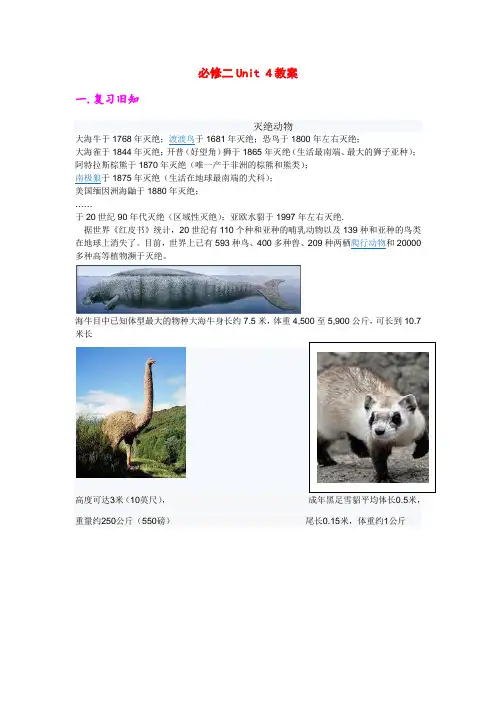
必修二Unit 4教案一.复习旧知灭绝动物大海牛于1768年灭绝;渡渡鸟于1681年灭绝;恐鸟于1800年左右灭绝;大海雀于1844年灭绝;开普(好望角)狮于1865年灭绝(生活最南端、最大的狮子亚种);阿特拉斯棕熊于1870年灭绝(唯一产于非洲的棕熊和熊类);南极狼于1875年灭绝(生活在地球最南端的犬科);美国缅因洲海鼬于1880年灭绝;……于20世纪90年代灭绝(区域性灭绝);亚欧水貂于1997年左右灭绝.据世界《红皮书》统计,20世纪有110个种和亚种的哺乳动物以及139种和亚种的鸟类在地球上消失了。
目前,世界上已有593种鸟、400多种兽、209种两栖爬行动物和20000多种高等植物濒于灭绝。
米长天蛾人(Mothman)是一种不明的奇异生物,又名黑天使,惟一的克星是上帝之网。
可以隐形,此时只有同伴相互可见,雌体较雄体强壮,每一具雌体都是雄体的启蒙者。
二.新课讲解1.As a result / as a result of区别as a result 作为状语来用,强调结果。
后面一般用逗号隔开。
as a result of + 名词(短语)/代词强调原因,意义相当于because of .Eg: He worked hard at his study. As a result, he passed the exam easily.As a result of his hard work, he passed the exam easily.2. Die outdie from 一般指除了疾病、情感、饥寒以外的原因而造成的死亡,指死于外因die of(内部因素)情感、疾病、饥寒死因die for为……而死,为……而献身,表示因事业或目的而死。
die out ①种类灭绝Elephants would die out soon if men were allowed to shoot.②逐渐消失Many old customs are dying out.③渐渐变小The fire died out in the enddie away 光、声音慢慢消失,风停下来He died from smoking/drinking……He hid behind the door until the footsteps had died away3. Reservevt. 1). 储备,保存;保留[(+for)]These seats are reserved for special guests. 这些座位是为特别的来宾保留的。
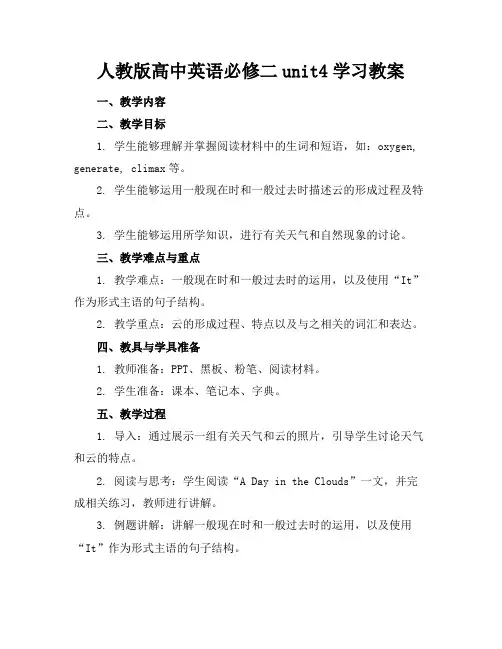
人教版高中英语必修二unit4学习教案一、教学内容二、教学目标1. 学生能够理解并掌握阅读材料中的生词和短语,如:oxygen, generate, climax等。
2. 学生能够运用一般现在时和一般过去时描述云的形成过程及特点。
3. 学生能够运用所学知识,进行有关天气和自然现象的讨论。
三、教学难点与重点1. 教学难点:一般现在时和一般过去时的运用,以及使用“It”作为形式主语的句子结构。
2. 教学重点:云的形成过程、特点以及与之相关的词汇和表达。
四、教具与学具准备1. 教师准备:PPT、黑板、粉笔、阅读材料。
2. 学生准备:课本、笔记本、字典。
五、教学过程1. 导入:通过展示一组有关天气和云的照片,引导学生讨论天气和云的特点。
2. 阅读与思考:学生阅读“A Day in the Clouds”一文,并完成相关练习,教师进行讲解。
3. 例题讲解:讲解一般现在时和一般过去时的运用,以及使用“It”作为形式主语的句子结构。
4. 随堂练习:学生完成Discovering Useful Structures部分的相关练习,教师进行点评。
5. 小组讨论:学生分组讨论,运用所学知识描述云的形成过程及特点。
六、板书设计1. Unit 4 A Day in the Clouds2. 词汇:oxygen, generate, climax等3. 句子结构:一般现在时、一般过去时,使用“It”作为形式主语七、作业设计1. 作业题目:根据课堂所学,写一篇关于云的形成过程及特点的短文。
2. 答案要求:使用一般现在时和一般过去时,不少于100词。
八、课后反思及拓展延伸1. 教师反思:关注学生在课堂上的参与程度,调整教学方法和节奏,以提高教学效果。
2. 拓展延伸:鼓励学生关注天气变化,观察云的形态,提高英语实际应用能力。
重点和难点解析1. 教学难点:一般现在时和一般过去时的运用,以及使用“It”作为形式主语的句子结构。
2. 例题讲解:讲解一般现在时和一般过去时的运用,以及使用“It”作为形式主语的句子结构。
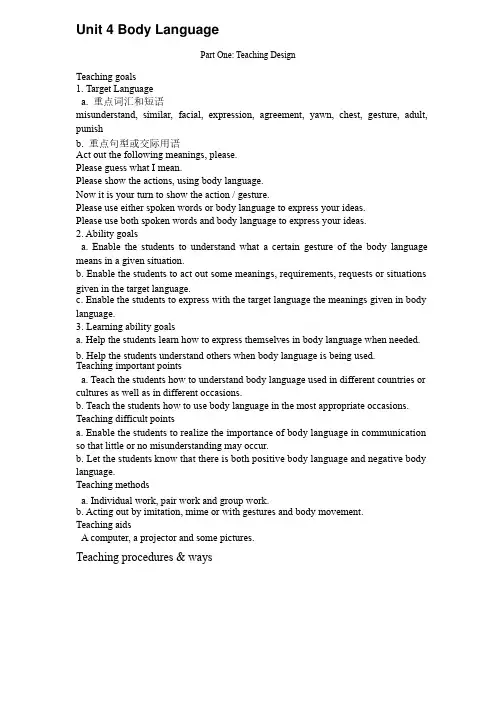
Unit 4 Body LanguagePart One: Teaching DesignTeaching goals1. Target Languagea. 重点词汇和短语重点词汇和短语misunderstand, similar, facial, expression, agreement, yawn, chest, gesture, adult, punishb. 重点句型或交际用语重点句型或交际用语Act out the following meanings, please.Please guess what I mean.Please show the actions, using body language.Now it is your turn to show the action / gesture.Please use either spoken words or body language to express your ideas.Please use both spoken words and body language to express your ideas.2. Ability goalsa. Enable the students to understand what a certain gesture of the body language means in a given situation.b. Enable the students to act out some meanings, requirements, requests or situations given in the target language.c. Enable the students to express with the target language the meanings given in body language.3. Learning ability goalsa. Help the students learn how to express themselves in body language when needed.b. Help the students understand others when body language is being used.Teaching important pointsa. Teach the students how to understand body language used in different countries or cultures as well as in different occasions.b. Teach the students how to use body language in the most appropriate occasions. Teaching difficult pointsa. Enable the students to realize the importance of body language in communication so that little or no misunderstanding may occur.b. Let the students know that there is both positive body language and negative body language.Teaching methodsa. Individual work, pair work and group work.b. Acting out by imitation, mime or with gestures and body movement.Teaching aidsA computer, a projector and some pictures.Teaching procedures & waysThe first period reading(COMMUNICATION: NO PROBLEM?)AimsTo help students develop their reading ability.To help students learn about body language.ProceduresI. Warming upWarming up by actingLook at the list of interpretation on the right side of the chart. Perform the action or the nonverbal behaviour on the left side.Examples Of Body LanguageWarming up by defining—What is body language?II. Pre-reading1. Looking and sayingLook at the man in the picture below. What does he say to you by his body language?Basically, how the ...... do I know? Or, I don’t know nothin! The shoulders are hunched and the hands are open signifying a big question mark.2. Talking and sharingBody language is the quiet, secret and most powerful language of all!According to experts, our non-verbal language communicates about 50% of what we really mean (voice tonality contributes 38%) while words themselves contribute a mere 7%.Our bodies send out messages constantly and often we don't recognize that we're communicating a lot more than we realize.Our understanding and use of non-verbal cues in facial expression are familiar to us nearly from birthIII. Reading1. Reading aloud to the recordingNow please listen and read aloud to the recording of the text COMMUNICATION: NO PROBLEM?. Pay attention to the pronunciation of each word and the pauses within each sentence. I will play the tape twice and you shall read aloud twice, too.2. Reading and underliningNext you are to read and underline all the useful expressions or collocations in the passage. Copy them to your notebook after class as homework.3. Reading to identify the topic sentence of each paragraphNext you are to skim the text to identify the topic sentence of each paragraph.4. Reading and transferring informationRead the text again to complete the table. Where is he/ she from? What does he/ she do when he/ she meet someone at the airport for the first time?Name Country Action MeaningMr GarciaJulia SmithAhmed AzizMadame Coulon5. Reading and understanding difficult sentencesAs you have read the text times, you can surely tell which sentences are difficult to understand. Now put your questions concerning the difficult points to me the teacher.6. Reading and translatingNow it’s time to translate the text into Chinese, sentence by sentence. Who will be the first to d o it?IV. Closing downClosing down by doing exercisesTo end the lesson you are to do the comprehending exercises No. 1 and 2 on page 26 and 27.Closing down by checkingC heck some of the following basic non-verbal cues and you'll recognize that you already speak and translate much of the language.“I’m surprised!” I’m shocked!” “I’m sad!”The second period Learning about Language(The ~ing form as the Attribute & Adverbial)I. Warming upWarming up by discovering useful words and expressionsTurn to page 27 and do exercises No. 1, 2 ,3 and 4 first. Check your answers against your classmates’.II. Learning about grammar1. Reading and thinkingTurn to page 25 and read with me the text of COMMUNICATION: NO PROBLEM? As you read along, pay attention to the uses of The ~ing form as the Attribute & Adverbial. (They are visitors coming from several countries. 作定语;Four people enter looking around in a curious way. 作状语;作状语; This is an exciting experience for you. 作定语; You stand watching and listening. 作状语;……)2. Doing exercises No. 1 and 2 on page 29Turn to page 29. Do exercises No. 1 and 2。
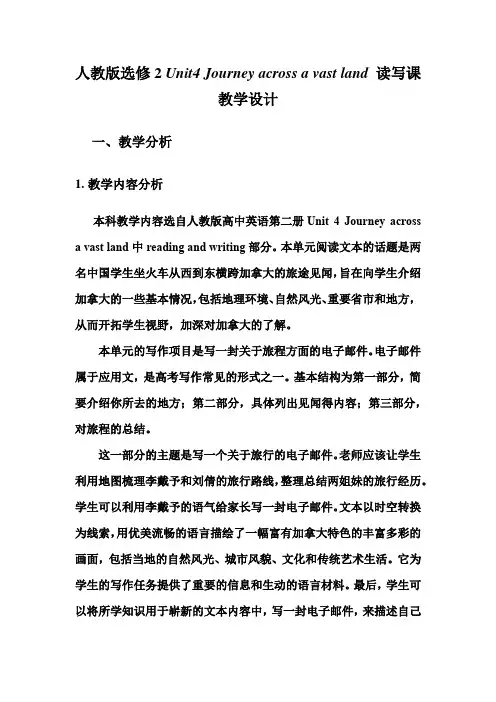
人教版选修2 Unit4 Journey across a vast land 读写课教学设计一、教学分析1.教学内容分析本科教学内容选自人教版高中英语第二册Unit 4 Journey across a vast land中reading and writing部分。
本单元阅读文本的话题是两名中国学生坐火车从西到东横跨加拿大的旅途见闻,旨在向学生介绍加拿大的一些基本情况,包括地理环境、自然风光、重要省市和地方,从而开拓学生视野,加深对加拿大的了解。
本单元的写作项目是写一封关于旅程方面的电子邮件。
电子邮件属于应用文,是高考写作常见的形式之一。
基本结构为第一部分,简要介绍你所去的地方;第二部分,具体列出见闻得内容;第三部分,对旅程的总结。
这一部分的主题是写一个关于旅行的电子邮件。
老师应该让学生利用地图梳理李戴予和刘倩的旅行路线,整理总结两姐妹的旅行经历。
学生可以利用李戴予的语气给家长写一封电子邮件。
文本以时空转换为线索,用优美流畅的语言描绘了一幅富有加拿大特色的丰富多彩的画面,包括当地的自然风光、城市风貌、文化和传统艺术生活。
它为学生的写作任务提供了重要的信息和生动的语言材料。
最后,学生可以将所学知识用于崭新的文本内容中,写一封电子邮件,来描述自己最难忘的一次旅行经历。
2.学情分析教学设计的对象是普通高校的高中生,这篇文章的难度适中。
主要谈论了加拿大的自然人文风光,学生们对于这一话题非常感兴趣,这为本课的学习提供了有利条件。
此外,经过了初中阶段的英语学习,他们已经有了一定的应用文写作的基础以及应用能力。
通过前三课时的学习,学生对本单元的话题有了充分的认知,对相关话题的词汇已有一定的掌握,语言的实际运用能力也有了一定的提高,能够根据话题表达自己的观点态度。
但是很多学生很少接触加拿大地理文化方面的知识,不熟悉电子邮件的格式、句式,较难将学到的词句转换成自己的语言写进应用文写作中。
因此,教师应采取读写结合教学法,指导学生从结构、语言和内容三个视角解读该教材文本。
Unit 4 Body language 教案示例(1)教学目的和要求(Teaching aims and demands)教学建议(Suggested teaching notes)一、教学内容分析本单元的中心话题是“身势语”。
身势语是非语言交际手段中非常重要的一个方面,它通过无声的语言表达一个人的内心自世界。
与有声语言一样身势语也是文化的载体,在跨文化交际中起着举足轻重的作用。
了解身势语的不同文化涵义并正确地加以运用,经常会在交际场合起到意想不到的好效果。
教师在教授本单元时,可以提醒学生注意自己和他人在日常交际中的体态、姿势、面目表情等等,正确地理解和运用身势语,以达到良好的交际效果。
“热身”(Warming Up)部分以列表对比的形式引导学生了解有声语言与身势语之间的对应关系,并建议学生把这些动作表演出来,既有趣味性,又有体验实践性。
“读前”(Pre-reading)部分首先引导学生对语言的目的、身势语的含义进行思考,随后引导学生联系自己日常生活的实际,想一想How can you tell if someone is sad even if they do not speak?最后一个问题,启发学生说出身势语在跨文化交际中的作用。
“阅读”(Reading)部分,以机场迎接客人为场景,讲述了几个不同国家的来宾由于文化背景的差异,初次见面时互相问候的方式迥然相异,而造成的一些小误会。
形象地表明了身势语与文化背景的密切关系,以及身势语在人们日常交际中的重要作用。
这部分的写作方式颇有特色,可以让学生在阅读过程中,很自然地以“你”的身份去观察、倾听在机场发生的一切。
“理解”(Comprehending)部分的前五个小题旨在检查学生对阅读篇章细节的理解,第六、七小题旨在引导学生对身势语的文化差异、身势语的意义进行积极的思考,第八小题则要求学生能够运用细节推断出主人公的性别。
“语言学习”(Learning about Language)部分要求学生根据英文释义填写本单元重点词汇,然后用课文中的词语填空和运用派生法变换词性。
Unit4SPACEEXPLORATION—Discovering高中英语必修教案教学设计Unit 4 Space ExplorationDiscovering Useful Structures【教学目标】1. Learn the structure, functions and features of infinitives.2. Learn to summarize some rules about infinitives to show purpose and modify.3. Learn to use infinitives in oral and writing English.【教学重难点】1. Learn to summarize some rules about infinitives to show purpose and modify.2. Learn to use infinitives in oral and writing English.【教学过程】Step 1 Lead in—Pair workLook at the following sentences and focus on the italicized infinitives. In pairs, discuss their functions.1. I trained for a long time to fly airplanes as a fighter pilot.(作目的状语)2. As we all know, an astronaut needs to be healthy and calm in order to work in space.(作目的状语)3. First of all, you must be intelligent enough to get a related college degree.(作目的状语)4. Some scientist were determined to help humans realize their dream to explore space.(作定语)5. On 12 April 1961, Yuri Gagarin became the first person in the world to go into space.(作定语)Summary:1.不定式的结构:to+do原形。
人教部编版高中英语必修第二册全册教案教学设计Unit 1 Cultural HeritageUnit 2 Wildlife protectionUnit 3 The internetUnit 4 History and traditionsUnit 5 MusicUnit 1 Cultural HeritagePeriod 2 Reading and Thinking:From Problems to Solutions【教材分析】1.This section focuses on "Understanding how a problem was solved,,, which is aimed to guide students to analyze and discuss the challenges and problems faced by cultural heritage protection during the construction of Aswan Dam, as well as the solutions. On the basis of understanding, students should pay attention to the key role of international cooperation in solving problems, and attach importance to the balance and coordination between cultural heritage protection and social and economic development. Students are encouraged to face challenges actively, be good at cooperation, and make continuous efforts to find reasonable ways and means to solve problems.【教学目标】1.Enable students to understand the main information and text structure of the reading text;2.Motivate students to use the reading strategy "make a timeline,, according to the appropriate text genre;3.Enable students to understand how a problem was solved;4.Enable students to understand the value of protecting cultural heritage by teamwork and global community;【教学重难点】1.Guide students to pay attention to reading strategies, such as prediction, self-questioning and scanning.2.Help students sort out the topic language about protecting cultural relics and understand the narrative characteristics of "time-event" in illustrative style3.Lead students to understand the value of protecting cultural heritage by teamwork and global community;【教学过程】1.PredictionStep 1 Predicting the main idea of the passageLook at the title and the pictures, and then predict what the passage will be about.Q: What will be talked about?Step 2: Fast reading tasksTask of the first fast reading:Read quickly and figure out the key words of each paragraph.•Paragraph 1: challenge•Paragraph 2: proposal led to protests•Paragraph 3: committee established•Paragraph 4: brought together•Paragraph 5: success•Paragraph 6: spiritTask of the second fast reading:1.Why did the Egyptian government want to build a new dam in the 1950s?2.Why did the building of the dam lead to protests?3.How did the government save the cultural relics?4.Which one can describe the project?A. Successful.B. Negative.C. Useless.D. Doubtful.5.What can be learned from the Aswan Dam project?Step 3: Careful reading tasksRead more carefully and answer the following questions.1.What do "problems" refer to and what do "solutions" refer to?2.Find out the numbers in paragraph four and explain why the author used exact numbers instead of expressions like many?3.What can you infer from "Over the next 20 years, thousands of engineers and workers rescued 22 temples and countless cultural relics"?4.What can you infer from "Fifty countries donated nearly 80 million to the project"?The project cost a lot of money.5.Before the building of the dam, what problems did the Nile River bring to the Egyptian?6.What words can you think of to describe the working process of the project?Step 4: ConsolidationDivide the passage into three parts and get the main idea of each part.Part 1 (Paragraph 1)The introduction of the topicKeeping the right balance between progress and the protection of cultural sites is a big challenge.Part 2 (Paragraphs 2-5)The process of saving cultural relics•Big challenges can sometimes lead to great solutions.•The Egyptian government wanted to build a new dam, which would damage many cultural relics.•The government turned to the UN for help.•Experts made a proposal for how to save cultural relics after a lot of efforts and the work began.•Cultural relics were taken down and moved to a safe place.•Countless c ultural relics were rescued.•The project was a success.Part 3 (Paragraph 6)The summary of the textThe global community can sometimes provide a solution to a difficult problem for a single nation.Step 5: Critical thinking:1.How to deal with the construction and the protection of cultural relics?2.As students, what should we do to protect our cultural relics?Step 6: summaryStep 7 Homework:Review what we have learned and find out the key language points in the text. 板书设计教学反思Unit 2 Wildlife ProtectionReading for Writing【教材分析】The activity theme is "making effective poster,,. The protection of wildlife needs the participation of the whole society. It is imperative to educate the public on wildlife protection and arouse the public's awareness and enthusiasm for wildlife protection. Teenagers are not only the main body of education, but also the "ambassador" of publicity and promotion. To make posters, students need to understand and study the situation of endangered animals and think about protection measures. In the process of reading and understanding the content of posters and making posters, students should be trained to master and use the style of posters, and their social responsibility and sense of responsibility should be cultivated.The reading text is two posters. The first poster, "give ugly a chance!" calls on people to protect all kinds of wild animals and not treat them differently because of personal likes and dislikes. No matter how beautiful or ugly animals are, they have the meaning and value of existence. The world is beautiful because of the diversity of biology. The article uses the tone of statement to make people unconsciously accept the author's point of view. The second POSTER "don't make paper with my home!,, adopts anthropomorphic rhetoric and takes koala's heart cry as the title, criticizing those behaviors of deforestation and destruction of animal homes. The text is a progressive explanation of the title. Exclamatory sentences and rhetorical sentences are used in this paper, which express the author's attitude and point of view. In addition, the title ofthese two posters uses exclamation sentences with strong appeal and emotional color, coupled with vivid pictures, making the posters more powerful.【教学目标】1.Cultivate students to acquire some features about an English poster by reading the text.2.Help students to write an English poster about animal protection properly using some newly acquired writing skills in this period.3.Develop students' writing and cooperating abilities.4.Strengthen students' great interest in writing discourses.【教学重难点】1.Stimulate students to have a good understanding of how to write an English poster properly.2.Cultivate students to write an English poster properly and concisely.【教学过程】Step 1: Lead inDo you want to be a volunteer of a pefs shelter? Why?Yes, I want to be a volunteer of it, because I want to help the pets, which are lovely and cute. I like them very much.Step 2: Read to discover details concerning the main details of the news report.I.Read the news report and then solve the questions below.1.Who started the rescue centre called the Small Friends Pet Shelter?A group of high school students and parents.2.What did the young people do in the shelter?Take care of animals.3.How do the young people think of their work?Worthwhile4.What help does the centre need?Volunteers, time and love.II. Read the text again and then choose the best answer.1.What should we do when we protect the wildlife animals?A.Treat all the wild animals equally.B.Only pay attention to less cute animals.C.Pay attention to cute animals.D.Care about endangered wildlife animals.2.Whafs the bad effect of cutting down billions of trees to make paper for humans?A.Make a lot of animals homeless.B.Make a number of wildlife animals dying out.C.The animals5 habitat is being destroyed.D.All of them.【答案】ADCStep 3: Study the organization and language features.1.Read the passage more carefully and write down the outline of the text.1.The Small Friends Pet Shelter was started by a group of high school students and their parents when they started to see many pets (that were left behind after their families moved away).译文:当一些高中生和他们的父母看到在主人搬走后,时,们建立了小朋友宠物收容所。
2020年新人教版高中英语必修二教案全套《Unit 1 Cultural Heritage》单元教案Period 1 Listening and Speaking & Listening and Talking【教材分析】Listening and Speaking introduces the topic of “Take part in a youth project”.The listening text is an interview about an international youth cultural heritage protection project. More than 20 high school students from seven countries participated in the project. The reporter interviewed two participants Stephanie and Liu Bin. By listening to the text, students can understand the significance of cultural heritage protection, and teenagers can use their knowledge, combine their own interests and advantages, etc. to participate in the action of cultural heritage protection.Listening and Talking introduces the theme of “Talk about history and culture”.The listening text is a dialogue between two tourists and tour guides when they visit the Kremlin, Red Square and surrounding buildings. The dialogue focuses on the functional items of “starting a conversation”, which is used to politely and appropriately attract the attention of the others, so as to smoothly start a conversation or start a new topic. The purpose of this section is to guide students to understand the history and current situation of Chinese and foreign cultural heritage in their own tourism experiences or from other people’s tourism experiences, explore the historical and cultural values, and be able to express accurately and appropriately in oral communication.【教学目标】1. Guide students to understand the content of listening texts in terms of the whole and key details;2. Cultivate students’ ability to guess the meaning of words in listening; discusswith their peers how to participate in cultural heritage protection activities.3. Instruct students to use functional sentences of the dialogue such as “I beg your pardon, but…” “Forgive me for asking, but…” and so on to start the conversation more politely and appropriately.【教学重难点】1. Guide students to understand the content of listening texts in terms of the whole and key details;2. Cultivate students’ ability to guess the meaning of words in listening; discuss with their peers how to participate in cultural heritage protection activities.3. Enable students to use the functional items of “starting a conversation”, which is used to smoothly start a conversation or start a new topic.【教学过程】Part 1: Listening and SpeakingStep 1: Lead inThe teacher is advised to talk about the meaning of the word “Heritage”.Boys and girls, before our listening, let’s work in pairs and discuss the meaning of the word “Heritage”.What does the word “heritage” mean? Share your ideas about your understanding of it and you can use examples to illustrate your meaning.Heritage means the traditional beliefs, values, customs, etc. of a family, country or society.For example, the Great Wall is the heritage of China.Step 2: PredictionAfter their small talk, the teacher can ask students to predict what the listening text is about by looking at the pictures.The listening text is probably about how to protect a famous heritage site by some students.Step 3: Summary of the main ideaThen play the radio which is about an interview about an international youth cultural heritage protection project. And after finishing listening for the first time, the students need to solve the following tasks.1. Listen to the conversation and sum up the main idea.Youths from seven countries are working together to protect cultural relics on Mount Tai.2. Listen again and help the reporter to complete the interview notes.International youth project, 23 high school students from 7 countriesMount Tai, one of the most famous mountains in ChinaIt has been protected for more than 3,000 years.22 temples, around 1,800 stones with writing on themDai Temple on Mount Tai; over 6,000 stepsStep 4: Guessing the meaning of the unknown wordsListen to the conversation again and use the context to guess the meaning of the words below. Tell the reasons why you guess so.Preserve: to protectReason: the word means the same of a word I knowPromote: to help sth to happen or developReason: The word is explained by the speakerStep 5: Speaking ProjectWork in pairs or groups and role play a conversation.Suppose you are a reporter and interviewing the students who devote their timeto protecting the heritage.Reporter: It is said that you are one of the volunteers to preserve the pine trees on Mount Huang. What are you guys doing?V olunteer: We are making some signs which are designed to educate people to protect the pine trees.V olunteer: Besides, we took a lot of pictures of pine trees and create an app which aims to promote people’s awareness of protecting the precious trees.Reporter: Sounds great and anything else?V olunteer: We often wear volunteer clothes and send some brochures in the park to call on more people to protect the trees.Reporter: Does your hard work pay off?V olunteer: Definitely. More and more tourists are now stopping carving names on the trees or climbing the trees.Part 2: Listening and TalkingStep1: Listen to the tape, which is about a dialogue between two tourists and a tour guide when they visit the Kremlin, Red Square and surrounding buildings for the first time, and then ask the students to solve the following tasks.1. Listen to the conversation and answer(1).Where are the speakers?On a street.(2).What are they doing?Sightseeing.2. What do you know about the Kremlin and Red Square? Listen again and complete the fact sheet.Step 2: Speaking ProjectActivity 3 on page 7.Work in groups. Choose a cultural site that you like and role-play a conversation between some tourists and their tour guide. Take turns to play the different roles.Step 3 HomeworkAccording to Activity 3, write down a conversation between the tourist and his/her guide.Unit 1 Cultural HeritagePeriod 2 Reading and Thinking:From Problems to Solutions【教材分析】1. This section focuses on “Understanding how a problem was solved”, which is aimed to guide students to analyze and discuss the challenges and problems faced by cultural heritage protection during the construction of Aswan Dam, as well as the solutions. On the basis of understanding, students should pay attention to the key role of international cooperation in solving problems, and attach importance to the balance and coordination between cultural heritage protection and social and economic development. Students are encouraged to face challenges actively, be good at cooperation, and make continuous efforts to find reasonable ways and means to solve problems.【教学目标】1. Enable students to understand the main information and text structure of the reading text;2. Motivate students to use the reading strategy “make a timeline” according to the appropriate text genre;3. Enable students to understand how a problem was solved;4. Enable students to understand the value of protecting cultural heritage by teamwork and global community;【教学重难点】1. Guide students to pay attention to reading strategies, such as prediction, self-questioning and scanning.2. Help students sort out the topic language about protecting cultural relics and understand the narrative characteristics of “time-event” in illustrative style3. Lead students to understand the value of protecting cultural heritage by teamwork and global community;【教学过程】1. PredictionStep 1 Predicting the main idea of the passageLook at the title and the pictures, and then predict what the passage will be about.Q: What will be talked about?Step 2: Fast reading tasksTask of the first fast reading:Read quickly and figure out the key words of each paragraph.•Paragraph 1: challenge•Paragraph 2: proposal led to protests•Paragraph 3: committee established•Paragraph 4: brought together•Paragraph 5: success•Paragraph 6: spiritTask of the second fast reading:1. Why did the Egyptian government want to build a new dam in the 1950s?2. Why did the building of the dam lead to protests?3. How did the government save the cultural relics?4. Which one can describe the project?A. Successful.B. Negative.C. Useless.D. Doubtful.5. What can be learned from the Aswan Dam project?Step 3: Careful reading tasksRead more carefully and answer the following questions.1. What do “problems” refer to and what do “solutions” refer to?2. Find out the numbers in paragraph four and explain why the author used exact numbers instead of expressions like many?3. What can you infer from “Over the next 20 years, thousands of engineers and workers rescued 22 temples and countless cultural relics”?4. What can you infer from “Fifty countries donated nearly 80 million to the project”?The project cost a lot of money.5. Before the building of the dam, what problems did the Nile River bring to the Egyptian?6. What words can you think of to describe the working process of the project?Step 4: ConsolidationDivide the passage into three parts and get the main idea of each part.Part 1 (Paragraph 1)The introduction of the topicKeeping the right balance between progress and the protection of cultural sites is a big challenge.Part 2 (Paragraphs 2-5)The process of saving cultural relics•Big challenges can someti mes lead to great solutions.•The Egyptian government wanted to build a new dam, which would damage many cultural relics.•The government turned to the UN for help.•Experts made a proposal for how to save cultural relics after a lot of efforts and the work began.•Cultural relics were taken down and moved to a safe place.•Countless cultural relics were rescued.Step 7 Homework:Review what we have learned and find out the key language points in the text.Unit 1 Cultural HeritagePeriod 3 Discovering Useful StructureRestrictive relative clauses【教材分析】This teaching period mainly deals with grammar “restrictive relative clauses.” To begin with, teachers should lead students to revise what they have learned about the relative pronouns and relative adverbs. And then, teachers move on to stress more special cases concerning this grammar, such as the “preposition+relative pronouns which and whom” and cases where we can omit the relative pronouns. This period carries considerable significance to the cultivation of students’ writing competence and lays a solid foundation for the basic appreciation of language beauty. The teacher is expected to enable students to master this period thoroughly and consolidate the knowledge by doing some exercises.【教学目标】1. Guide students to review the basic usages of relative pronouns and adverbs of attributive clauses.2. Lead students to learn to use some special cases concerning restrictive relative clauses flexibly.2. Enable students to use the basic phrases structures flexibly.3. Strengthen students’ great interest in gram mar learning.【教学重难点】1. Help students to appreciate the function of relative pronouns and adverbs of attributive clauses in a sentence2. Instruct students to write essays using the proper relative pronouns and adverbs of attributive clauses.【教学过程】本节语法思考:定语从句在复合句中的作用是什么?关系词有哪些?定语从句在复合句中的作用相当于形容词,它在句中作定语修饰名词或代词。
教案设计
四、教学方法
1.自主学习:让学生课前预习,自主查找与本课时相关的内容。
2.合作探究:小组合作从网络上查找关于野生动植物的图片和资料,帮助他们熟悉话题以便于他们在学习过程中积极参与和主动探索。
3.结合多媒体技术,采用资源式、探究式的教学方法;注重交际活动,实施开放性讨论
五、教学过程
Step 1 Words preview
1._______far away in space or time
2. ___________to go down to a lower level
3. _________to do something to make a change
4. ________able to control events
5. _________打猎,猎取,搜寻
6. __________鉴赏,感激意识到
7. ____________保护…不受…伤害
8._________ 回答,响应
Step 2 Leading-in
1. Show a shot move about Wildlife Protection 成龙呼吁保护野生动物公益广告成龙
呼吁保护野生动物公益广告(英语)- 视频- 优酷视频- 在线观看
2. Have them in pairs discuss why they are endangered and show students some pictures. Step 3 Pre-reading
Show students some information about wildlife protection from the Internet and ask students to discuss the following questions in pairs,
1. What is wildlife protection about?
2. What endangered species do you know?
3. Why are they in danger of disappearing?
Step 4 Fast reading
1.Read the passage quickly, and finish the main idea .
Daisy took _____________to travel and talked with ____________ in her dream, which made her know _____________ of the wildlife protection.
2. Read quickly and silently, finish the true or false questions.
人教版新课标必修二第四单元
一、说教材
1、教材的地位及作用
本单元以保护动物为话题,旨在通过本单元的学习使学生了解很多动物已经灭绝或濒临灭绝,从而认识到保护动物的重要性和必要性。
并且通过探讨保护动物的措施和建议,引导学生发表自己的见解和看法,唤起学生保护动植物、维护生态平衡、保护我们家园的责任感。
本课Reading讲述的是一篇童话故事——Daisy乘坐飞毯跨越时空和藏羚羊、大象、猴子对话的神奇经历。
通过故事,帮助学生逐渐认识到保护野生动物的重要性,并了解该如何保护野生动物,号召人们热爱动物,保护动物,从我做起。
在本单元中,Reading前面的Warming up及pre-reading是该部分的铺垫,后面的listening, speaking等几部分都是Reading的延伸和扩展。
所以说Reading部分承载了本单元的主要信息,又集中了大量的有用词汇和语言结构,起到承上启下的作用。
(根据教学大纲及新课程的要求,确立了本课的教学目标及教学重难点。
)
2、教学目标
(1)认知目标
a、重点词汇和短语:wild, wildlife, protection, decrease, loss, reserve, hunt, zone, peace, respond,
distant, mercy, importance, powerful, affect, attention, appreciate, secure, die
out, in peace, in danger of, in relief, burst into laughter, protect…from…, pay
attention to
b、重点句式:Daisy had always longed to help endangered species of wildlife. (L.1)
I’m protecting myself from mosquitoes. (L.28)
No rainforest, no animals, no drugs. (L. 31)
But what an experience! (L.35)
(2)技能目标
•通过阅读,训练学生获取语篇信息、分析、处理、利用信息的能力;
•掌握猜测、略读、扫读的阅读技巧;
•掌握如何保护野生动物的知识;
•培养学生口头表达能力。
(3)情感目标
让学生学会如何保护野生动物,进一步意识到野生动物的生存环境日益恶化以及保护野生动物的行动刻不容缓。
3、教学重、难点
•让学生了解野生动物保护的知识;
•提高学生的阅读能力。
二、说学情
新课程强调“以人为本,以学生为主体”的教学思想。
那么作为一名合格的教师,了解学生是我们最基本的职责。
作为高中阶段的学生对周围的事物较为敏感,有自己的观点和看法,他们不满足于教科书上的知识,想获得更多的信息。
在英语学习上,他们不只是想把英语作为一门死记硬背的课程来学,更希望能学到知识性和趣味性兼有的内容,从英语学习中获得更多的知识和能力。
但是他们的词汇量是有限的,并且缺乏阅读技巧。
且从学生学习语言的规律来看,高一年级是学生的阅读能力提高的重要阶段。
而从以往普通班的教学来看,学生在阅读一篇300字以上的文章时,阅读速度较慢,有许多不好的习惯,如逐字阅读,朗读式阅读等等。
其次,他们的理解正确率往往低于70%。
三、说教法。